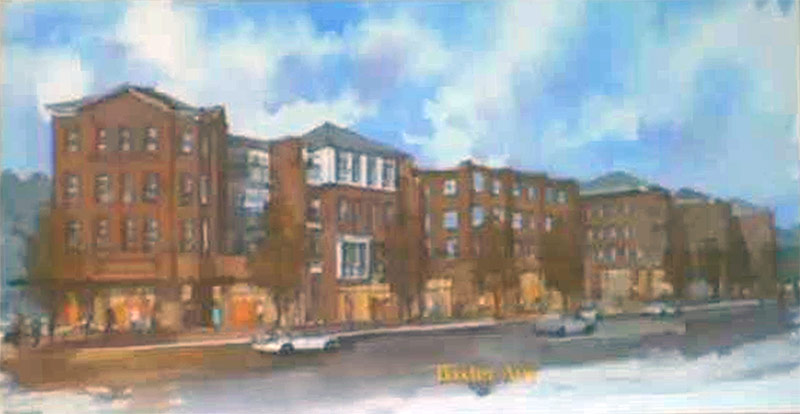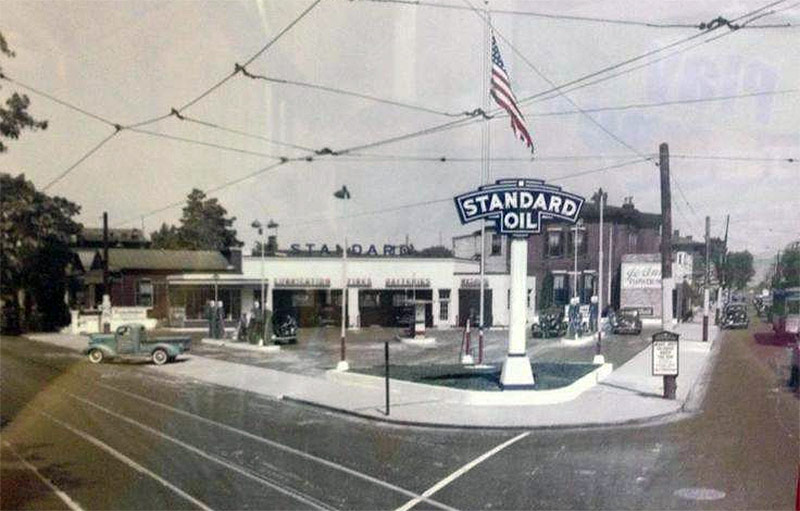
On Tuesday, October 6, Columbus, Ohio–based developers at the Edwards Companies held a public meeting to discuss their proposal to build a mixed-use project on a sizeable assemblage including the old Phoenix Hill Tavern site at the corner of East Broadway and Baxter Avenue.
Last month, we spoke with Jonathan Wood, vice president at the Edwards Companies, ahead of the meeting to find out initial details about his company’s plans. “As it appears, there’s an opportunity to develop something that would be great for the neighborhood and be better than what’s there today,” Wood told Broken Sidewalk in September. “We want to understand if the opportunity exists that we believe exists.” This week he explained those plans in more detail to the neighborhood.

The Phoenix Hill Tavern site is just down the street from another project by the Edwards Companies, a 200-unit apartment building on the former campus of Mercy Academy at 1170 East Broadway. That plan just cleared its last hurdle and is now ready for construction, which is expected to commence early next year.
At Tuesday’s meeting, the Edwards Companies revealed a conceptual rendering that appears to be of a similar style and massing of Lupton Rausch Architecture’s Mercy Apartments. The rendering shows a four-story building with three floors of apartments over ground floor retail. The project could include 200 to 300 apartment units. A parking garage would be built in the center of the block.
That rendering is intended as only a first draft, according to WDRB’s Ryan Cummings who was at the meeting. He reported that the developer will take community input from the meeting and update the plan in more detail by the end of the year. There will be another meeting to discuss the update.


As we pointed out before, the site is a hodgepodge of surface level parking lots, several houses, three historic commercial buildings along Baxter Avenue (pictured above), and cinderblock modern buildings. The acute-angle corner is today a parking lot, formerly housing a gas station dating back to the 1930s.
The concept rendering appears to show a tabula rasa scheme where the entire site is cleared, something Wood previously said would be the case. “We’ve looked at [the Phoenix Hill Tavern site] as if it were a blank canvas—as a piece of dirt,” Wood said in September. “It’s obviously not a piece of dirt. It’s a neighborhood with a lot of charm and history and it has buildings on it.” He hinted that some buildings would have to be torn down to make the project feasible on such an irregularly shaped lot.
Stay tuned as more details emerge on this one.



It’s these people that give developers the negative public image they have.
How so?
I’m not an architect, just a fan of good design, but it seems to me that the concept does a decent job of creating a potentially lively urban streetscape where none existed before. The scale seems right; the street-level retail is great; the parking is hidden. I wouldn’t have gone for quite such a traditional design, but people’s tastes vary, and it does suit the neighborhood. If they can incorporate the historic buildings, so much the better, but speaking honestly, “historic” is something of a stretch — they’re examples, pretty beat up, of older Louisville architecture. The magnificent
Will Sales building on Fourth Street that got razed too long ago to remember (Brandon, can you find a photo?) — now, that was historic.
What’s wonderful about the buildings is that they’re local
Neighborhood architecture, the architecture of the everyday, the buildings that make up most of the great streets we have. Grading buildings by high style is a grave error and will give you sterile pale
Imitations of renderings that have been seen over and over and over again.
The Will Sales and two dozen of its closest friends are now dust. The “little” buildings matter too. Better native than Carthage; its easy to build with the buildings intact. And we have plenty of development sites available that are already dead space.
Buildings don’t go bad without alot of human help. Whiskey Row was pretty beat up too……
@yokevino these kinds of developments take away pieces of what makes a neighborhood attractive (to developers and everyone else), like a leech pulling blood from a host it adds nothing positive to a neighborhood. It only exists to feed a greedy tasteless, visionless developers pockets. If everyone did what these jobs of people do there wouldnt be any neighborhood worth invading. This kind of development. Like the monstrosity in butchertown, masquerades as progress when its really a harbinger of neighborhood death. Bleach to a tapestry.
There’s such a thing as making the perfect the enemy of the good.
To condemn this proposal as some sort of soul-sucking blight on the neighborhood seems, to me, rather short-sighted and extreme. I, too would prefer to save the houses there. But I also would vastly prefer this development to the parking lots and defaced buildings that are there now. This isn’t the Taliban blowing up revered Afghan religious relics; it’s a mixed-use development in a place that sorely needs it, on a spot that is by no means in good shape. Most everything in this city replaced something else. It’s not always a travesty, though, granted, it too often is.
It’s definitely an improvement over what’s currently there.
Youll see. These leeches are a death rattle for Bardstown. Chipping away at what made the area what it is until the people that made it what it is find a different neighborhood and move.
If the shotgun houses so valued
Post Katrina (beware what you wish for) are junk blame the house hoarder Rogers family for whom blight was a secondary career. This is the character of this corridor. Destroy it at your peril for sterile renderings of over dense sameness when its the quirkiness that keeps this part of Louisville weird, and defines it. Or just go blow up the 600-800 blocks of East Market by comparison and see how well you
Like it . History is not just high style buildings – try Paris or Amsterdam or any walkable city that doesn’t depend on parking garages and other things we really don’t need here. Incorporating new and old is not only sustainable and green, its what people gravitate to. You cannot recreate what’s already Indigenous and no out of state developer has a
Clue. We do not need 10,000 néw high rent units. Density in the Highlands is well established without this injection of foreign sameness. What some of you take for granted and would trade out for this overblown development is painful to watch.
No mention of enhanced public transportation, pedestrian
Connectivity, or human scale. This company has done a number of urban restorations with infill. And a host of easy peasy suburban dreck. And they would no more decide to blow up a block of German Village in their own back yard. This is our backyard, and what happens here matters.